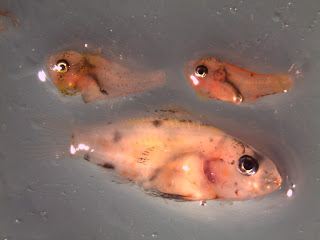Justin Suca
is a rising senior attending the University of Miami and majoring in Marine
Science. He works in our lab (the Early Life History Lab of SEFSC) as a Lab
Assistant supporting multiple projects that include identifying fishes and
curating our multifaceted datasets.
 |
| Justin collecting H20 from the DCM for pCO2 |
Justin has been on this cruise for almost
28 days now! In between filtering water, identifying fishes, taking optic measurements and
deploying gear, Justin shared with the blog: “I want to gain more experience
with field work at sea and I am interested in stable isotope applications for
pelagic fishes [especially mahi mahi] for spatio-temporal comparisons and variation with depth. I would
like to see if the samples collected in this cruise display 15δN enrichment at
increasing depths. The application of physical ocean features to patterns in
plankton distribution is another area which this cruise gives me an opportunity
to expand my knowledge."
 |
| Justin and Raul looking for tuna and mahi mahi |
"When I began at the lab, I knew very little about
larval fish. However, as my knowledge and experience with them has increased
over the past two years, it has become a field that I would like to continue to
work in, perhaps through a doctorate."
 |
| Mahi Mahi juveniles collected in plankton tows |
"I was on last year’s cruise but my
overall understanding of the science and reasoning behind the procedures and
station plotting is much greater now, making this cruise a valuable experience."
We will miss Justin as he leaves the cruise to pursue his next science-adventure at Woods Hole Oceanographic Institution (WHOI)! We thank Justin for supporting the cruise with his enthusiasm and intoxicating fish-energy!!






















